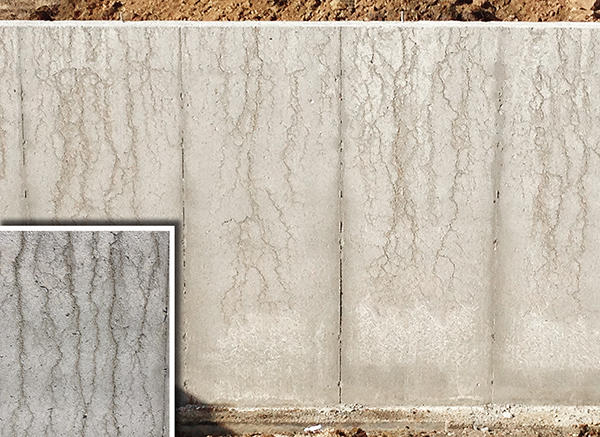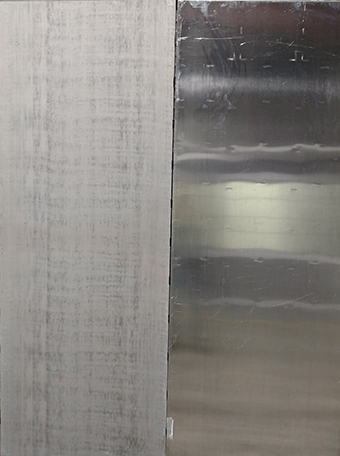Dealing With the Reactivity of Aluminum Forms and Concrete
By Destry Kenning, Forming Market Segment Manager, Nox-Crete Products Group
Part 1 of a 4-Part Series
Anyone who has placed concrete against new or older reconditioned and not properly seasoned aluminum forms is most likely familiar with the veins or worm-like trails that form in the resulting concrete, and also familiar with the excessive concrete buildup that occurs on the form surfaces. These problems occur because the elemental aluminum present in the aluminum forms is very reactive with the cementitious materials in concrete. Unfortunately, these problems typically continue for three or four additional pours, and possibly even longer depending on the method used to deal with buildup on the form surfaces.
As mentioned, elemental aluminum reacting with the cementitious materials results in concrete buildup on the form surfaces. This buildup occurs because of shared chemical bonds between the aluminum and the cementitious materials. These chemical bonds are different and much stronger than the physical bonds that might result if, for example, no release agent is used on a nonreactive form surface. Concrete buildup as a consequence of chemical bonding is much more difficult to remove than buildup from a physical bond.
Another effect of this reaction is the presence of hydrogen gas, which creates bubbles on the formed, freshly placed, concrete surfaces. By migrating upward and escaping out of the top of the wall, these bubbles ultimately create the all-too-familiar veins or worm-like trails. It is important to note that the hydrogen gas bubbles are not likely to form bugholes in the concrete like those caused by entrapped air. Hydrogen gas bubbles weigh much less than the air we breathe and therefore tend to migrate up the wall much easier than does entrapped air.

Elemental aluminum reacting with the cementitious materials in concrete produces hydrogen gas, which causes veins or worm-like trails in the surface of the concrete – Photos courtesy of Precise Forms Inc. and Carroll Construction Supply/Dalaco.
There are steps you can take to prevent these problems. One option is to apply some type of resinous coating on the aluminum form surfaces.
A heavy coating or application will create a barrier between the aluminum form surfaces and the concrete, eliminating the potential for a chemical reaction between the two. However, the coating will ultimately succumb to the abrasion and scratching that occurs during the handling and transport of aluminum forms, and to the abrasion caused by repeated concrete pours against the form surfaces. Reapplication of the same coating becomes far more challenging because the remainder of the existing coating typically needs to be removed, along with any concrete buildup or form release agent residual that might interfere with the adhesion of the second coating application.
A thin coating or application is sometimes suggested. There is the understanding that it will wear out fairly quickly, but it has the advantage of minimizing the amount of elemental aluminum that can react with the concrete in any one pour. The idea is that this will reduce the amount of concrete buildup on the form surfaces and surface irregularities in the poured concrete.
Unfortunately, both coating methods are little more than temporary solutions, as they do not mitigate the underlying reactivity of the elemental aluminum. Once the coating is gone, the same problems remain.
A more effective method for dealing with the elemental aluminum is to make it react with something in advance to prevent or greatly minimize any further reaction when concrete is placed against the form surfaces. The idea is to convert the elemental aluminum on the form surfaces to aluminum oxide, a process typically done with an alkaline solution or slurry. This process is frequently referred to as “seasoning.”

Seasoned aluminum form on left, unseasoned on the right – Photo courtesy of Precise Forms, Inc.
One seasoning method is the field application of a lime slurry. Contractors have been doing this for years; however, this method has been met with mixed results and is far from 100 percent effective in dealing with the aluminum reactivity.
An alternative and more effective option than the traditional lime slurry, is to utilize a product that is specifically designed for the aluminum form seasoning process. These proprietary products are also field applied, but they are typically more reactive than lime and therefore more effective in converting the elemental aluminum to aluminum oxide. To ensure positive results, some of these products also contain cleaning agents that remove mill oil or grease frequently found on new aluminum forms.
Even though these proprietary products perform much better than the traditional lime slurry, they are still not 100 percent effective. Also, as with the lime slurry method, these treatments will need to be combined with highly reactive form release agents for the first few pours to achieve the best results.
Temperature sensitivity is an issue for both the traditional lime slurry and the proprietary products. If the form temperature drops below 70° F, the effectiveness decreases. By the time form temperatures are in the 40s, the results are typically poor. This does not necessarily mean that you cannot complete the process at air temperatures below 70° F. In fact, the form temperature is more important than the air temperature. If the forms are laid out in direct sunlight, they will typically heat up well beyond the air temperature in a short period of time.
The final method for seasoning involves the submersion of the entire form in a tank filled with a proprietary product specifically designed for the seasoning process. This method requires great care and understanding of the process, as it is quite hazardous and could easily result in form damage or worker injury. For these reasons, this process is generally done by the aluminum form manufacturers in a controlled environment. That said, there are only a couple of aluminum form manufacturers that actually offer this service.
Of the three seasoning methods described, the dip tank method is the most effective for seasoning aluminum forms, but it also typically costs the most. The dip tank method should be followed by the use of a highly reactive release agent for the first few pours, to complete the seasoning process.
Regardless of the seasoning method used, it is always a good idea to use a highly reactive release agent and a low alkali content concrete mix for the first few pours. A low alkali concrete mix can be achieved with a low alkali cement and/or through the use of certain mineral admixtures, such as Class F fly ash. Local ready mix concrete producers should be able to assist the contractor in meeting this requirement.
During the first few pours after the forms are initially seasoned, it is good to avoid the use of calcium chloride in the concrete. Also, next-day form stripping in cold weather conditions should be avoided.
Lastly, the aluminum oxide layer that develops on the aluminum form surface during the seasoning process is very thin and somewhat delicate for the first few pours. Accordingly, extra care must be taken during these initial pours to prevent excessive abrasion and scratching during concrete placement against the aluminum forms, as well as during the handling and transport of the forms.
For more information about form seasoning, please visit www.nox-crete.com or contact Destry Kenning at DKenning@nox-crete.com or 402-504-9232.









